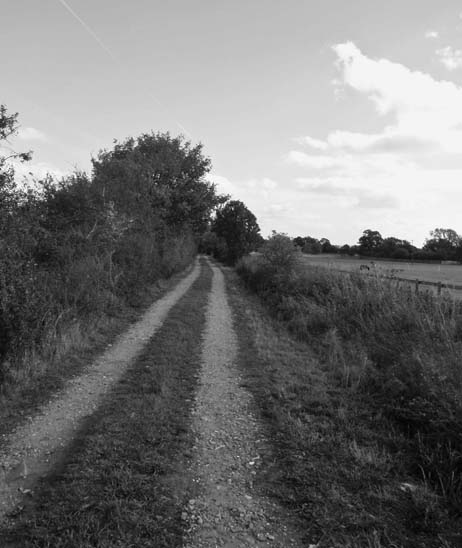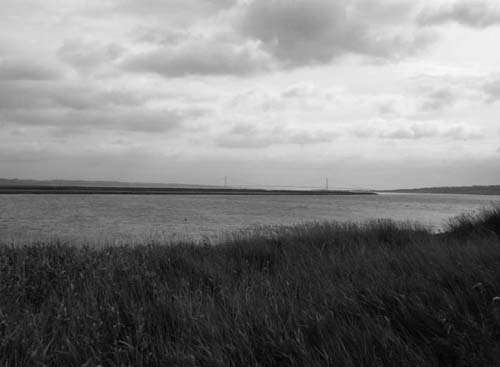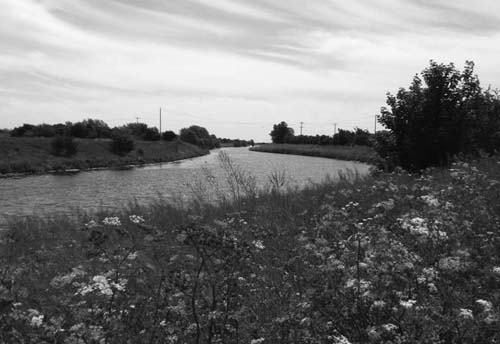Folklore of Lincolnshire (12 page)
Read Folklore of Lincolnshire Online
Authors: Susanna O'Neill


The reputedly haunted Bonnewells Lane, Bransby.
Daniel Codd relates a story of a Black Dog haunting a small cottage in Gainsborough in 1823.
7
This creature seemed to be more on the malevolent side than Rudkin’s apparitions, delivering sinister tappings at the window, door and bedposts. It also exhibited poltergeist behaviour, often directed towards a young girl in the house and, as far as Codd is concerned, the creature was never banished.
On his webpage, Dr Simon Sherwood describes an experience of the Black Dog he had as a child, living in Spalding in the 1970s.
8
He recalls how he was asleep in bed, when he was suddenly woken by the patter of feet. When he opened his eyes he saw a huge dog, with horns, sprinting along the hall towards his bedroom. The dog had massive, bright yellow eyes and when it reached the door to the bedroom it disappeared. The boy’s scream attracted his mother’s attention and she persuaded him it had merely been the reflection of car headlights. It was only later, as an adult, whilst reading the newspaper that he came across a story of a poltergeist haunting in a council house. Apparently a number of objects had been thrown at the baby in the house, and the father also said he had seen a large, dark dog run at him, then disappear. This particular story would seem in accordance with Codd’s poltergeist Black Dog – more on the evil side than Rudkin’s reported experiences.
Sean McNeaney describes a malevolent Black Dog, witnessed by a farm worker somewhere on the outskirts of Hemswell.
9
He is said to have inadvertently dug up the bones of some large animal. He presumed it to be a donkey or calf, but on closer inspection he saw it possessed rather ferocious-looking canine teeth. He placed the skull in a sack and decided to take it along to his local pub to show his friends. It was a cold, dark winter’s night and the journey was along narrow isolated lanes. When he was but halfway, he was overcome with a feeling of dread and began to glance over his shoulder at regular intervals, although he saw nothing untoward. Shortly, however, he heard the sound of heavy, lumbering padded feet and the panting of some huge creature fast approaching. This time when he looked behind, his eyes fell on a massive Black Dog, running at him with bared teeth and burning red eyes. The horrified man began to run but the creature quickened its pace and was soon upon him. He could feel its breath on the back of his neck, and he only had the sack of bones to protect him. With this in mind he suddenly turned and slammed the sack into the head of the beast and the bag tore, spilling the bones all around the two figures. As the bones crashed to the ground, splintering into fragments, the hound gave a horrific howl and then vanished right before his eyes. The poor man’s friends laughed at his tale, at first, but soon began to believe him, when his deathly-pale expression did not change, and ever after the farm worker was terrified of all dogs.
The Black Dog is not the only supernatural canine creature to inhabit Lincolnshire. Strangely enough, there are also reports of werewolf sightings, which some find harder to believe than the Black Dog apparitions.
Daniel Codd tells the tale of a certain wolf man who used to inhabit Read’s Island about 200 years ago. There was a travelling vagabond, who had built himself a small shelter on the island and earned his living rowing people across the
waters in his small boat. During his stay on the island, however, it is said that there were frequent mysterious disappearances and eventually one passenger tipped off the authorities and the drifter was taken before the courts and accused of cannibalism. More evidence presented itself when the island was searched and hundreds of human bones were found scattered around his abode. Quite why there was so much traffic to this small island is never explained. The most disturbing part of the story tells that, during the trial, the traveller ‘collapsed vomiting on to all fours, howling like an animal. His appearance began to take on the form of a monstrous wolf and there was an immense struggle to subdue him.’
10
No other information is given, except that he was hauled off to the countryside and then hanged. No one knows who he was or where he came from, least of all why he metamorphosed into a wolf.
There is another story, based in the neighbourhood of Gedney Dyke, concerning a witch by the name of Old Mother Nightshade. On account of her strange habits and the noises she made, she was feared by all those who lived nearby except one young lad, John Culpepper. The poor lad was something of a simpleton and found himself in the witch’s lair one day, seeking advice on matters of the heart, after being spurned by the village beauty, Rose Taylor.

Read’s Island, a small piece of land not far from the bank, in the River Humber. The Humber Bridge can be seen from its shores.
The old witch gave the boy a box of sweetmeats which he was to offer to the lady in question, then after three days he was to return to her. The lad obeyed these instructions and on the night of the full moon he found himself again in the
presence of the witch. ‘Close your eyes until I tell you to open them,’ the witch commanded. John did as he was bidden and eventually a strange, distorted voice told him to open them. The young man was aghast when he opened his eyes to see before him a gigantic wolf-like creature with long, shaggy hair looming over him. The poor lad, now tied to the chair, realised too late that he had been tricked, and the wolf-woman bore down on him and ripped him to shreds. The villagers all cowed behind their locked doors that night, hearing the screams and ungodly howls which filled the air, and in the morning the witch was gone and John’s ragged remains were all that was left. Some huge, bloodied paw prints led off into the Fens, too big to belong to a dog, and the villagers realised at last what the witch had been. The cottage was burnt to the ground, but still the wolf’s howl can sometimes be heard echoing across the Fens on the night of a full moon.
It is said that in those times, perhaps around the eighteenth century, it was believed that witches possessed the knowledge to mix certain ingredients into an ointment which, when rubbed on the skin, transformed them into a wolf-like creature. Another tale reinforces this idea; that of an old wizard who lived in Northorpe, near Bourne. He is reputed to have been seen turning into one of these wolf-like creatures and attacking his neighbour’s cattle. At least it wasn’t his neighbour!
Britain has relatively few werewolf stories, compared with some other countries in the world, but this could be due to the fact that wolves have been extinct here for such a long time and folklore concerning them has died out. There are only a few remaining stories, and luckily Lincolnshire is one area that still has some of these tales.

The area where the werewolf bones were supposedly dug up, aptly named Dogdyke.
Codd narrates a legend from the 1800s of a student who discovered the bones of a human skeleton with a wolf’s head in the peatland near Dogdyke. He was so excited with his unusual find that he took the bones home in order to study them more closely. That night, however, he was woken by a tapping at the window. When he looked outside into the night he saw ‘a moving, black shape; peering closer the form defined itself as a human being with a wolf’s head, which was looking at him through the glass and snarling viciously. The creature drew back its clawed arm to smash the glass…’
11
Of course, the young man fled, terrified, into the adjacent room where he could barricade himself in; he sat ‘frozen with fear’ for the rest of the night, listening to the prowling and padding sounds of the wolf creature in his house. In the morning, after he was sure the sounds had ceased, he ventured into the rest of the house, which had been turned upside down. The terrified lad immediately took the bones back to where he had found them and buried them deep in the peat. He never saw the beast again.
Christopher Marlowe mentions a few of these werewolf stories and adds another about an artist who was visiting the Fens around Crowland on a break from her home in London.
12
She was staying with a family and was on the way home to their farm one evening when she came across a local widow wandering in the lane. The lady seemed to be acting rather oddly and lagged behind the artist. As she looked back, the widow suddenly seemed to drop to her knees in the lane and then, before her very eyes, she watched her transform into a horrifying wolf creature. The werewolf came at the artist and she had the presence of mind to shine her pocket torch into the creature’s eyes. It vanished immediately. When she arrived back at the farmhouse she found the widow there, and the family said she had been in their presence all the time but had at one point fallen to the floor complaining she had been blinded by lightning. In this instance, Marlowe proposes that she had telepathically projected herself to attack the artist, in the form of a wolf. This theory fits the idea that witches could transform themselves into wolf creatures – but she went even one step further, by projecting that form in one place while simultaneously being present as a human elsewhere.
One wonders at the popular tales depicted in books and films in today’s world, of werewolves, vampires, zombies and the like. There is such a common theme amongst these stories, based on folk tales from all around the world, that there must be a grain of truth to them, no matter how far removed from the creatures on the big screen today.
Codd talks of a fear of zombie-like creatures being prevalent in Lincolnshire in the 1800s.
13
Apparently, some workmen dug up a skeleton of a man at Yaddlethorpe Hill, Bottesford. This man had been buried with a stake driven through his chest, which was apparently common practice with suicides. The recovered body would have a stake driven through the heart and then the corpse would be buried in quicklime at some crossroads, for faster disintegration, for fear it would rise again.
Folklorists Gutch and Peacock relate a similar tale, told to them by the rector of Wispington, about a dead fellow who was placed in his coffin overnight, but the next morning the body had disappeared and in its place was a pile of stones.
14
They go on to say that it was the custom in Lincolnshire to always tie together the feet of the dead when the body was placed in the coffin, otherwise there was the fear that they could return or that some other spirit may take over the body. They use the example of Old Will Richardson, of Croft, whose feet were not tied when he died. Two weeks later, a visitor went round to the widow’s house and was greeted by the daughter, who explained her mother was in rather a state. She realised she had forgotten to tie her late husband’s feet together in his coffin and that he had come back and seated himself in the corner. They were too terrified to move him. On inspection, the visitor saw a huge toad sitting beneath the old man’s chair and the belief was that the old man had come back in this form – something which could have been avoided if his feet had been tied.
Westwood and Simpson tell the tale of another frightening creature that visited an old gentleman in his bedroom at night, in South Ferriby.
15
They say that the old man could never have a good night’s rest, as the curtains around his bed would draw themselves back and forth and then twist around his neck, as if to strangle him. One night other objects around the house began to move and make a terrible racket and so the man had to admit to his daughter what had been happening. He informed her that the apparition had told him he must go out that very night and meet the fiend on the hill behind the church, alone. He was too frightened to go and so ignored the order, but as he was ascending the stairs to bed that night something grabbed him on the way and tried to strangle him there and then. He agreed he would go to the hill and so the next night he set out alone, as requested, and when he returned he was visibly shaken. When his daughter questioned him about what had happened, he refused to discuss it and told her never to ask him again, but promised that it was finished and the thing would bother them no more. He was true to his word, but to what cost we shall never know.
